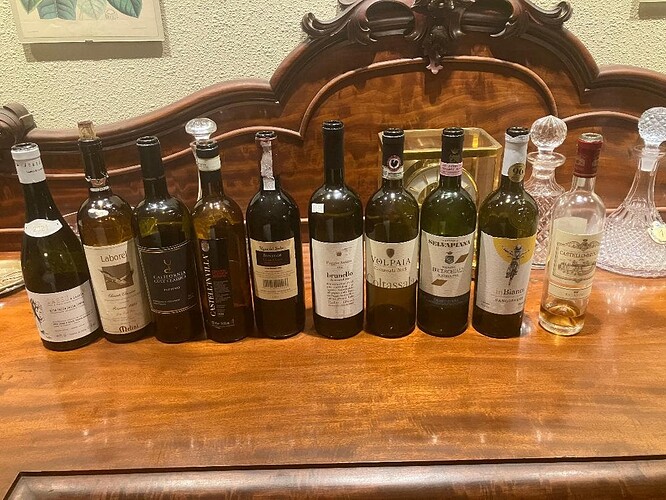Notes from a blind tasting of Tuscan wines:
We had a very enjoyable assortment of whites to start – not always the case, as in this theme people tend to gravitate toward reds.
2020 Barbanera in Bianco Toscana IGT – yes, a white sangiovese! Wet stone and fruit nose, hints of sweetness in the finish. Ends clean and dry.
2021 Jurij Fiore & Figlia Lassù a Lamole – this trebbiano was showing more colour and had an interesting vitamin tablet nose. Smooth refreshing wine.
2020 Elena Casadei Ansonaco – made from Asonica grapes (usually grown only much further south). Interesting wine showing more colour, some oak in the nose plus a slightly viscous mouth feel, ending cleanly and dry. They leave skins in for longer than normal so technically am orange wine, though not very dark in colour.
1995 Fattoria Selvapiana Chianti Rùfina Riserva Bucerchiale – my wine was the first red. I bought this on release (tasted a bottle and ran out and picked up a case). It is showing some browning at the age of 29, and garnet edges. Very nice nose of dark cherry and red fruit notes, a nicely balanced middle and a nice long clean finish. The nose just kept on improving in the glass.
1995 Melini Chianti Classico Riserva Laborel – excellent colour, and the nose showed considerably more development than the previous wine, but it still drank surprisingly well.
1990 Poggio Antico Brunello di Montalcino – this was the wine I had chosen for my wife, who was sitting in to fill the spot of an absent member, to offer. Still fairly dark, with garnet edges, showing good sweet fruit along with some earthy leathery notes. Very decent length. My last bottle.
2015 Castello di Volpaia Chianti Classico Gran Selezione Coltassala – a dark wine showing significant tannin as well as excellent fruit levels, finished with a hint of heat. A fleshy wine just coming into prime time.
2010 Castell’in Villa Chianti Classico Riserva – very dark with a sweet dark cherry nose, smooth middle and velvety ending. Someone suggested that it was the Mel Tormé of wines. Excellent.
2008 Castello Di Bossi Corbaia – a 70% Sangiovese and 30% Cabernet Sauvignon wine aged in new French oak barrels. Very decent, drank well with good length.
2008 Fontodi Chianti Classico Riserva Vigna del Sorbo – dark, ripe and seemed young, with slightly high terminal acidity. Decent super-Tuscan
With cheese we had two wines. The first was a sangiovese, but a North American one, made from Napa grapes sourced via Ray Signorello, shipped to Vancouver and vinified a few miles from me.
2011 California Cult Classics Peppino – vary dark concentrated wine, but some nice flavours. Certainly not at all subtle, but well liked by the group. IMHO the best wine of those made up here – the others are concentrated and in some cases cloying.
2011 Barone Ricasoli Vin Santo del Chianti Classico Castello di Brolio – deep amber colour, figs and nuts in the nose, was very sweet on palate and had nicely offsetting acidity. Well done, if not my favourite style of sticky.
